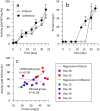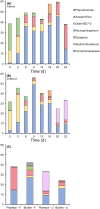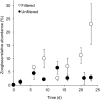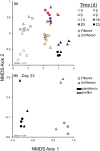Use of in-field bioreactors demonstrate groundwater filtration influences planktonic bacterial community assembly, but not biofilm composition
- PMID: 29558522
- PMCID: PMC5860781
- DOI: 10.1371/journal.pone.0194663
Use of in-field bioreactors demonstrate groundwater filtration influences planktonic bacterial community assembly, but not biofilm composition
Abstract
Using in-field bioreactors, we investigated the influence of exogenous microorganisms in groundwater planktonic and biofilm microbial communities as part of the Integrated Field Research Challenge (IFRC). After an acclimation period with source groundwater, bioreactors received either filtered (0.22 μM filter) or unfiltered well groundwater in triplicate and communities were tracked routinely for 23 days after filtration was initiated. To address geochemical influences, the planktonic phase was assayed periodically for protein, organic acids, physico-/geochemical measurements and bacterial community (via 16S rRNA gene sequencing), while biofilms (i.e. microbial growth on sediment coupons) were targeted for bacterial community composition at the completion of the experiment (23 d). Based on Bray-Curtis distance, planktonic bacterial community composition varied temporally and between treatments (filtered, unfiltered bioreactors). Notably, filtration led to an increase in the dominant genus, Zoogloea relative abundance over time within the planktonic community, while remaining relatively constant when unfiltered. At day 23, biofilm communities were more taxonomically and phylogenetically diverse and substantially different from planktonic bacterial communities; however, the biofilm bacterial communities were similar regardless of filtration. These results suggest that although planktonic communities were sensitive to groundwater filtration, bacterial biofilm communities were stable and resistant to filtration. Bioreactors are useful tools in addressing questions pertaining to microbial community assembly and succession. These data provide a first step in understanding how an extrinsic factor, such as a groundwater inoculation and flux of microbial colonizers, impact how microbial communities assemble in environmental systems.
Conflict of interest statement
Figures





Similar articles
-
In-field bioreactors demonstrate dynamic shifts in microbial communities in response to geochemical perturbations.PLoS One. 2020 Sep 28;15(9):e0232437. doi: 10.1371/journal.pone.0232437. eCollection 2020. PLoS One. 2020. PMID: 32986713 Free PMC article.
-
Impact of hydrologic boundaries on microbial planktonic and biofilm communities in shallow terrestrial subsurface environments.FEMS Microbiol Ecol. 2018 Dec 1;94(12):fiy191. doi: 10.1093/femsec/fiy191. FEMS Microbiol Ecol. 2018. PMID: 30265315 Free PMC article. Review.
-
Biofilm and planktonic bacterial communities in a drinking water distribution system supplied with untreated groundwater.Arch Microbiol. 2018 Nov;200(9):1323-1331. doi: 10.1007/s00203-018-1546-7. Epub 2018 Jun 28. Arch Microbiol. 2018. PMID: 29955926
-
Influence of Simplified Microbial Community Biofilms on Bacterial Retention in Porous Media under Conditions of Stormwater Biofiltration.Microbiol Spectr. 2021 Oct 31;9(2):e0110521. doi: 10.1128/Spectrum.01105-21. Epub 2021 Oct 27. Microbiol Spectr. 2021. PMID: 34704792 Free PMC article.
-
Diversity and assembly patterns of activated sludge microbial communities: A review.Biotechnol Adv. 2018 Jul-Aug;36(4):1038-1047. doi: 10.1016/j.biotechadv.2018.03.005. Epub 2018 Mar 15. Biotechnol Adv. 2018. PMID: 29551616 Review.
Cited by
-
Mechanism Across Scales: A Holistic Modeling Framework Integrating Laboratory and Field Studies for Microbial Ecology.Front Microbiol. 2021 Mar 24;12:642422. doi: 10.3389/fmicb.2021.642422. eCollection 2021. Front Microbiol. 2021. PMID: 33841364 Free PMC article.
-
In-field bioreactors demonstrate dynamic shifts in microbial communities in response to geochemical perturbations.PLoS One. 2020 Sep 28;15(9):e0232437. doi: 10.1371/journal.pone.0232437. eCollection 2020. PLoS One. 2020. PMID: 32986713 Free PMC article.
-
Impact of hydrologic boundaries on microbial planktonic and biofilm communities in shallow terrestrial subsurface environments.FEMS Microbiol Ecol. 2018 Dec 1;94(12):fiy191. doi: 10.1093/femsec/fiy191. FEMS Microbiol Ecol. 2018. PMID: 30265315 Free PMC article. Review.
References
-
- Walker CB, He Z, Yang ZK, R JA Jr., He Q, Zhou J, et al. The electron transfer system of syntrophically grown Desulfovibrio vulgaris. J. Bacteriol. 2009;191(18):5793–801. doi: 10.1128/JB.00356-09 - DOI - PMC - PubMed
-
- Branda SS, Vik A, Friedman L, Kolter R. Biofilms: the matrix revisited. Trends in Microbiology. 2005;13(1):20–6. doi: 10.1016/j.tim.2004.11.006 - DOI - PubMed
-
- de Kievit TR. Quorum sensing in Pseudomonas aeruginosa biofilms. Environ. Microbiol. 2009;11(2):279–88. doi: 10.1111/j.1462-2920.2008.01792.x - DOI - PubMed
-
- Hall-Stoodley L, Costerton JW, Stoodley P. Bacterial biofilms: from the natural environment to infectious diseases. Nat. Rev. Microbiol. 2004;2(2):95–108. doi: 10.1038/nrmicro821 - DOI - PubMed
-
- Besemer K, Peter H, Logue JB, Langenheder S, Lindstrom ES, Tranvik LJ, et al. Unraveling assembly of stream biofilm communities. ISME J. 2012;6(8):1459–68. doi: 10.1038/ismej.2011.205 - DOI - PMC - PubMed
Publication types
MeSH terms
Substances
LinkOut - more resources
Full Text Sources
Other Literature Sources

